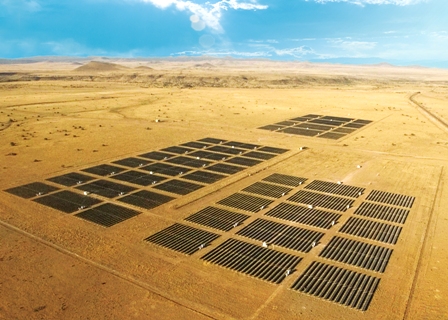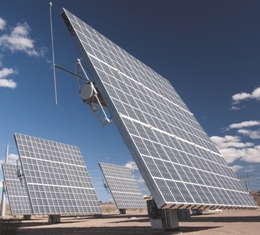
Raising Arizona (solar): Tucson Electric primes the PV pump with 100MW-plus program
Jun 09, 2010 - Tom Cheyney- PV-tech.org
There are few places on the planet more suitable for solar power than Arizona. Despite the obviousness of this desert-fried fact, the state trails its large, golden neighbor to the west in the amount of PV and CSP installed as well as megawattage in the development pipeline. But two recently announced programs from a pair of Arizona’s main utility operators—Tucson Electric Power and Salt River Project —would bring a couple of hundred more megawatts online within the next couple of years, and in TEP’s case, provide a distributed test bed for a variety of PV technologies.

TEP’s plan has already gone through the request for proposal stage, where 144 submissions from 58 companies were sorted through to come up with seven winners, with which it has signed 20-year power purchase agreements. The firms chosen will build 10 solar PV power plants, totaling 107MW installed, from which the utility will buy the output. The power company has submitted the agreements to the Arizona Corporation Commission for review, possibly at this month’s meeting, and awaits a decision.
SRP has just got the PV ball rolling, issuing a request for proposals (RFP) for utility-scale, ground-based solar photovoltaic power plants, preferably between 5 and 20MW in capacity. The idea is to add up to 50MW of ground-mounted PV capacity by the third-quarter 2012 and another 50MW a year later, with the projects preferably interconnected in SRP’s service territory across a couple of counties in the sprawling metro Phoenix area.
Between the two programs, as much as 207MW of new PV systems would be plugged into the Arizona grid within three years, representing an exponential increase of solar-power generation used by the firms—especially for SRP, which currently has a measly megawatt or so under sun.
TEP, well down the path in its plan, may see its PPA partners putting shovels in the ground by the end of this year, as long as the commission doesn’t dilly-dally. Joe Salkowski of the UniSource Energy-owned utility told me on May 28 last that “the timing of the ACC’s review is entirely up to the ACC. We would hope to have these approved soon, but beyond that I don’t have much to say in terms of timing.”
The ACC has approved other, similar requests from TEP in recent months, giving the thumbs up to the utility to add 1.8MW of new capacity to its existing 4.6MW Springerville PV array as well as to another 1.6MW system to be built by Solon elsewhere in Tucson (both of which will be completed this year, he said).
“We’ve asked the commission to sign off on the contracts to give us an indication that these are the sorts of contracts that they would like us to proceed with,” the spokesman explained.
“The agreement we’re seeking from the commission now is that as we sit here today, these look like responsible contracts of the sort we ought to be moving forward with. We believe that gives us enough assurance that we can move forward and it provides the developers with the ability to secure financing for their projects.”
Since financing (AKA bankability) is crucial to the success of any PV project development, the importance of ACC’s approval is critical.
Some details of the TEP 10 can be found in the application (a public document) submitted by TEP to the commission for approval of the renewable energy PPAs. Although the companies involved have left some of the specifics of their proposed projects a bit vague, one intriguing element is the presence of 16MW of concentrator PV in the mix from Amonix and Emcore.
Both CPV companies plan to build 2MW arrays in the University of Arizona’s Science and Technology Park’s 200-acre “Solar Zone,” located in the UASTP’s 1345-acre development in southeast Tucson.
The university’s Campus Research Corp. has already approved the terms and conditions of 20-year ground leases for Amonix’s 12-acre plot and a 9.3-acre space for Emcore (and its partner, American National Solar). Estimated design and construction costs are stated at $30 million for the Amonix plant and $5 million for the Emcore site.

Amonix also plans to build a substantially larger system in Swan Quarry, a 10MW array that would be the largest CPV installation in North America and in the world for that matter, if it were completed today.
Two other companies also plan to install PV fields in the UASTP Solar Zone. Foresight FSP Solar Two will spend $17.5 million to design and build a 4MW single-axis tracker system of as-yet unknown type on 37.3 acres, while CTC Electric’s First Light unit will fit out a stationary 5MW installation for about $15 million on 58.6 acres elsewhere in the zone.
FSP also will post 12MW of single-axis-tracked panels in an as-yet-to-be-determined location on TEP’s turf.
The two largest PPA projects among the TEP 10 will be a 35MW farm owned by Avalon Solar and a 25MW field run by NRG Solar. Avalon’s fixed arrays will be sited on fallow farmland held by Tucson Water in the burg of Marana, while the NRG project location has yet to be finalized.
The final pair of projects will be built out by Solon, a pair of single-axis-tracked 5MW plants in a, you guessed it, yet-to-be-determined site.
Although the types of non-CPV modules to be deployed have not been announced, I’d bet that Solon will be using its own panels manufactured in its factory in Tucson. I’d also wager that First Solar’s CdTe mods would be in the running for the NRG site, since the two companies already have a good partnership thing going at the 21MW solar farm in Blythe, CA.
It would be cool to see CIGS panels from Global Solar also have a presence among the TEP 10, especially given its location within the confines of the UASTP’s Solar Zone, a zone which puts a lot of emphasis on including “assembly/manufacturing” facilities and R&D labs as well as power-generation plants in its vision statement.
The more variety of modules the merrier, as far as fans of comparative PV test beds are concerned. Two sets of CPV technologies going pretty much head-to-head with a combination of crystalline and thin-film modules will make the TEP 10 an intriguing source of real-world data once the systems come online.
The utility’s Springerville Generating Station Solar System (SGSSS) (shown at top of blog) already has provided substantive comparative data since its inception in 2004, as it includes modules from Schott, BP Solarex, and early CdTe models from then-upstart First Solar.
“We’re looking forward to seeing which of those technologies works best for us and our customers,” noted Salkowski.
(SRP’s just-announced program, which will have a web-based conference for interested parties on June 15, will only consider crystalline-silicon or thin-film PV panels and fixed-tilt or single-axis tracking technology—sorry, CPV fans.)
The other biggish PV project in TEP’s PPA portfolio is being developed by Fotowatio Partners, a single-axis tracker-based farm near Marana. He said that Fotowatio is “preparing research and materials for its conditional use permit from Pima County and hopes to have the system completed in 2011.”
Add up the newly PPA’ed PV with the already-approved projects, and TEP figures to harvest as much as another 135MW-plus of sun juice for its corner of the grid by 2012.
Even if that number shrinks a bit through financing woes, permitting hang-ups, SB 1070-related boycotts (no comment), or other types of possible project attrition, TEP will be in the top ranks of solar-minded midsized utilities and well on its way to meeting its state-mandated Renewable Energy Standard requirements.
Now it’s up to the ACC to greenlight Tucson Electric’s latest PPAs and get the party started.

|